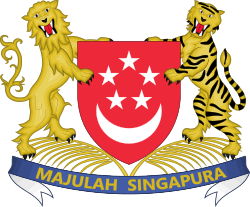Tourism in Singapore
Tourism in Singapore is a major industry and contributor to the Singaporean economy, attracting 17.4 million international tourists in 2017, more than 3 times of Singapore's total population.[1] It is also environmentally friendly, and maintains natural and heritage conservation programs. Along with this, it also has one of the world's lowest crime rates. As English is the dominant one of its four official languages, it is generally easier for tourists to understand when speaking to the local population of the country, for example, when shopping. Transport in Singapore exhaustively covers most, if not all public venues in Singapore, which increases convenience for tourists. This includes the well-known Mass Rapid Transit (MRT) system. Singapore is the 5th most visited city in the world, and 2nd in Asia-Pacific.[2]
| Part of a series on the |
| Economy of Singapore |
|---|
 |
| Economic history of Singapore |
| Sectors |
|
|
|
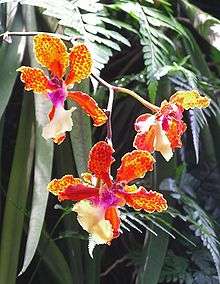

The Travel and Tourism Competitiveness Report 2017 ranks Singapore 13th out of 136 countries overall, which was the third best in Asia only behind Japan (ranked 4th) and Hong Kong (ranked 11th). The report ranks Singapore's business environment, international openness, also travel and tourism policy and enabling conditions as the best in the world (ranked 1st). However, the island nation scored rather low in natural and cultural resources sub-index (ranked 40th).[3][4]
The Orchard Road district, which is dominated by multi-storey shopping centres and hotels, can be considered the center of tourism in Singapore. Other popular tourist attractions include the Singapore Zoo, River Safari and Night Safari, which allows people to explore Asian, African and American habitats at night without any visible barriers between guests and the wild animals. The Singapore Zoo has embraced the 'open zoo' concept whereby animals are kept in enclosures, separated from visitors by hidden dry or wet moats, instead of caging the animals, while the River Safari, features 10 different ecosystems around the world, including the River Nile, Yangtze River, Mississippi, Amazon as well as the Tundra and has 300 species of animals, including numerous endangered species.[5]
Jurong Bird Park is another zoological garden centred on birds, which is dedicated towards exposing the public to as much species and varieties of birds from around the world as possible, including a flock of one thousand flamingos. The tourist island of Sentosa, which attracted 19 million visitors in 2011, is located in the south of Singapore, consists of about 20–30 landmarks, such as Fort Siloso, which was built as a fortress to defend against the Japanese during World War II.
Guns from the World War II era can be seen at Fort Siloso, from a mini-sized to a 16 pound (7 kg) gun. Moreover, the island has built the Tiger Sky Tower, which allows visitors to view the whole of Sentosa, as well as the Sentosa Luge, a small one- or two-person sled on which one sleighs supine and feet-first. Steering is done by shifting the weight or pulling straps attached to the sled's runners. Among the latest tourists attractions built in Singapore includes the two integrated resorts which houses casinos, namely Marina Bay Sands and Resorts World Sentosa, a Universal Studios theme park and Gardens by the Bay.
Tourism statistics
Singapore attracted approximately 19.1 million visitors in 2019 with receipts at S$27.1 billion, according to preliminary figures by the Singapore Tourism Board.[6]
Singapore attracted approximately 18.5 million visitors in 2018, according to Singapore Tourism Board. This number increased by 6.2 percent from 2017, which likely is due to an increase in arrivals from Asia, USA, and the United Kingdom. Top three markets included visitors from China, Indonesia, and India, due to strong travel demand and increased flight connectivity. Indian travel also escalated due to new cruise offerings from top cruise lines. Overall, 14 out of Singapore's top 15 markets were able to log growth in the 2018 year and are expected to continue doing so through 2019. Speaking monetarily, increase of tourism receipts was largely due to growth in entertainment, gaming and sightseeing.
Singapore attracted 15,095,152 visitors in 2014, according to the Singapore Tourism Board's statistics,[7] but which excludes Malaysian visitors who visited Singapore via the Causeway or the Second Link. This was a 3% decrease from 2013, due to a decline in arrivals from China, Singapore's second largest market.
Total visitor days was a record 56 million days, a growth of 3%, or an average of 3.7 days per visitor. 21% of visitors were day-trippers, while 79% stayed for a day or more. 78% of visitors arrived by air, 10% by sea, and 12% by land. The largest age group of visitors was from 25 to 34 years old at 23% of visitors, followed by 21% for those aged 35–44 and 17% for those from 45 to 54 years old.
The visitors came from the five biggest markets, mainly Indonesia, People's Republic of China, Malaysia, Australia, and India. But in 2016, People's Republic of China tourists number has overlapped Indonesian tourists number.[8]
Tourism receipts was estimated at S$23.6 billion in 2014, compared to S$18.9 billion in 2010, with Sightseeing, Entertainment & Gaming accounting for 24.7% of total expenditure, Accommodation making up 22.5%, Shopping accounting for 17.4% and Food and Beverage another 9.6%. Medical receipts, representing the medical-tourism industry in the country contributed 4.2%.
Gazetted hotel room revenue was estimated at S$3.15 billion, an increase of 7.7% over 2013. The overall average occupancy rate was at 85%, 0.9% lesser than 2013, with the Upscale tier seeing the largest increase of 1%. Overall average room rate remained flat at S$258, while the overall revenue per available room was S$221, an decrease of 0.9% over 2013.
General trends
| Year | Tourism Arrivals | [9] Percentage change from previous period |
|---|---|---|
| 1965 | 99,000 | |
| 1970 | 579,000 | 488.1% |
| 1975 | 1,324,000 | 128.6% |
| 1980 | 2,562,000 | 92.% |
| 1985 | 3,031,000 | 18.3% |
| 1990 | 5,323,000 | 75.6% |
| 1995 | 7,137,000 | 34.1% |
| 2000 | 7,691,399 | 7.76% |
| 2005 | 8,943,029 | 16.27% |
| 2010 | 11,638,663 | 30.14% |
| 2015 | 15,231,469 | 30.86% |
Recent years
| Year | Tourism Arrivals | [9] Percentage change from previous year |
|---|---|---|
| 2010 | 11,641,700 | 20.2% |
| 2011 | 13,171,303 | 13.1% |
| 2012 | 14,496,091 | 10.1% |
| 2013 | 15,567,923 | 7.4% |
| 2014 | 15,095,152 | −3% |
| 2015 | 15,231,469 | 0.9% |
| 2016 | 16,402,593 | 7.7% |
| 2017 | 17,422,826 | 6.2% |
| 2018 | 18,506,619 | 6.2% |
Top markets 2000–2010
Source: Singapore Tourism Board[10]
| Country or territory | 2000 | 2001 | 2002 | 2003 | 2004 | 2005 | 2006 | 2007 | 2008 | 2009 | 2010 |
|---|---|---|---|---|---|---|---|---|---|---|---|
| 1,313,316 | 1,364,380 | 1,393,020 | 1,341,747 | 1,765,324 | 1,813,569 | 1,922,217 | 1,962,055 | 1,765,429 | 1,745,330 | 2,305,149 | |
| 434,336 | 497,398 | 670,099 | 568,510 | 880,259 | 857,814 | 1,037,201 | 1,113,956 | 1,078,742 | 936,747 | 1,171,337 | |
| 564,750 | 578,719 | 548,659 | 439,437 | 537,336 | 577,987 | 634,303 | 645,774 | 647,480 | 764,309 | 1,036,918 | |
| 510,347 | 550,681 | 538,408 | 392,906 | 561,163 | 620,255 | 691,632 | 768,490 | 833,156 | 830,299 | 880,486 | |
| 346,360 | 339,828 | 375,697 | 309,487 | 471,244 | 583,590 | 658,902 | 748,728 | 778,303 | 725,624 | 828,903 | |
| 929,895 | 755,766 | 723,431 | 434,087 | 598,840 | 588,535 | 594,406 | 594,514 | 571,040 | 489,987 | 528,817 | |
| 181,032 | 190,630 | 195,564 | 176,585 | 245,918 | 319,971 | 386,119 | 418,775 | 418,938 | 432,072 | 544,344 | |
| 285,975 | 276,157 | 265,970 | 226,260 | 271,691 | 313,831 | 291,474 | 302,110 | 278,115 | 294,420 | 387,552 | |
| 246,750 | 260,958 | 263,866 | 235,826 | 341,989 | 379,040 | 356,367 | 353,416 | 333,905 | 317,905 | 430,022 | |
| 385,585 | 343,805 | 327,648 | 250,678 | 333,156 | 371,440 | 399,786 | 408,885 | 396,631 | 370,704 | 416,990 | |
| 354,353 | 359,083 | 371,050 | 261,403 | 361,083 | 364,206 | 454,722 | 464,292 | 423,018 | 271,987 | 360,673 | |
| 444,976 | 460,018 | 458,528 | 387,982 | 457,262 | 467,154 | 488,167 | 495,693 | 492,933 | 469,756 | 461,714 | |
| 31,837 | 34,633 | 40,652 | 44,420 | 105,803 | 150,626 | 165,105 | 203,210 | 239,299 | 265,414 | 322,853 | |
| 290,904 | 222,087 | 209,321 | 144,942 | 182,443 | 213,959 | 219,463 | 208,156 | 175,924 | 156,761 | 191,173 | |
| 169,408 | 166,981 | 157,510 | 121,376 | 142,371 | 154,779 | 161,125 | 164,900 | 175,280 | 183,681 | 209,231 |
Top markets 2011–2018
Source: Singapore Tourism Board[9]
| Country or territory | 2011 | 2012 | 2013 | 2014 | 2015 | 2016 | 2017 | 2018 |
|---|---|---|---|---|---|---|---|---|
| 1,577,522 | 2,034,177 | 2,269,870 | 1,722,380 | 2,106,164 | 2,863,582 | 3,226,929 | 3,416,475 | |
| 2,592,222 | 2,837,537 | 3,088,859 | 3,025,178 | 2,731,690 | 2,893,614 | 2,954,384 | 3,021,429 | |
| 868,991 | 894,993 | 933,553 | 943,636 | 1,013,986 | 1,097,186 | 1,272,069 | 1,442,242 | |
| 1,140,935 | 1,231,686 | 1,280,942 | 1,233,035 | 1,171,077 | 1,151,480 | 1,168,356 | 1,253,992 | |
| 956,039 | 1,050,373 | 1,125,179 | 1,074,878 | 1,043,568 | 1,027,309 | 1,081,987 | 1,107,215 | |
| 656,417 | 757,116 | 832,845 | 824,741 | 789,179 | 783,721 | 792,813 | 829,664 | |
| 677,723 | 656,804 | 687,794 | 676,481 | 673,374 | 691,555 | 736,456 | 778,135 | |
| 440,576 | 477,213 | 491,946 | 484,912 | 499,509 | 516,276 | 565,250 | 643,162 | |
| 414,879 | 445,184 | 471,768 | 536,975 | 577,082 | 566,503 | 631,359 | 629,451 | |
| 332,231 | 366,234 | 380,495 | 424,408 | 418,266 | 469,409 | 531,359 | 591,600 | |
| 442,611 | 446,497 | 461,459 | 451,931 | 473,810 | 489,205 | 518,903 | 588,863 | |
| 472,708 | 477,654 | 497,409 | 506,509 | 516,409 | 546,384 | 531,307 | 545,601 | |
| 464,375 | 472,167 | 539,810 | 631,029 | 609,888 | 537,964 | 465,769 | 473,113 | |
| 238,488 | 282,203 | 350,308 | 337,431 | 378,026 | 394,174 | 395,549 | 422,935 | |
| 219,952 | 252,433 | 251,560 | 263,513 | 286,732 | 328,762 | 342,336 | 356,797 |
Sightseeing Bus fleet
Historically, their fleet were made up of second-hand step-entrance double deckers in 2001–2004 for the City Sightseeing/Singapore Ducktours operation in Singapore, but new open-top buses were arrived beginning January 2006. Their electronic destination displays were added since January 2006 to replace roller-blinds in stages, which uses Mobitec MobiLED in larger font. As of 2020, Singapore Ducktours has 66 buses (only 3 of them are hybrid buses), Big Bus Company has 20 buses, Golden Tours/Gray Line has 18 buses and Singapore City Tours have 12 buses.
Sightseeing Bus Routes
| Route Number & Colour | Route Name | Places served | Duration of service (approx.) | Other notes |
|---|---|---|---|---|
| 670 | The Loop Line | ITE College East, Bugis MRT station, North Bridge Commercial Complex, City Hall, Boat Quay, Chinatown, Clarke Quay, Liang Court, Hotel Miramar, Zion Food Centre, Botanic Gardens, Orchard Road, City Hall, Suntec City | 62 minutes | N/A |
| H1 Green |
Tampines City Route | Tampines Primary and Secondary Schools, Changi General Hospital, ITE College East, Stratford Court, Bedok Mall, Ping Yi, Arc @ Tampines, Temasek Polytechnic | 45 minutes | |
| H2 Blue |
Tampines Metropolis Route | Tampines Primary and Secondary Schools, Ashford Station, Changi General Hospital, ITE College East, Parc Lumiere, Tampines East CC, Tampines JC, Tampines Central CC | ||
| H3 Red |
Tampines Original | Tampines Primary and Secondary Schools, Centrale 8, Tampines Central, IKEA Tampines, Tampines Central CC, Tampines City Hub | 35 minutes | |
| H4 Brown |
Tampines Original | Tampines Primary and Secondary Schools, East View Secondary School, Tampines East MRT station, Flora Road, Pasir Ris | 52 minutes | |
| T1 Brown |
The Original Tour | Singapore Flyer, Ritz-Carlton, Esplanade, Clifford Pier, Cross Street, Tanjong Pagar, Tiong Bahru, Havelock Road, Hotel Miramar, National Gallery Of Singapore | 35 minutes | |
| T3 Green |
Chinatown Tour | Resorts World Sentosa, Shenton Way, Anson Road, Cecil Street, Raffles Place, Victoria Concert Hall, Raffles Hotel, Kampong Glam, V Hotel Lavender (ELD Training Centre) | 40 minutes | Two-way service |
| T6 Purple |
Heritage Corridor | Suntec Hub, Marina Bay Sands, Victoria Concert Hall, Bugis, Fu Lu Shou Complex, Mustafa Centre, Kallang Bahru | 40–45 minutes | |
| T7 Lime |
Stadium Wave | Marina Bay Sands, Esplanade, Seating Gallery, Bugis MRT station, Lavender MRT station, Kallang MRT station, Singapore Sports Hub | 40 minutes | N/A |
| T10 Pink |
NTU-Lien Ying Chow Tour | Suntec City, AYE, National University of Singapore, Clementi, Jurong East (Jurong Gateway), AYE, Jurong Point, Pioneer MRT station, Nanyang Technological University | 110 minutes | |
| T18 Blue |
Unknown | Singapore Flyer, Ritz-Carlton, SMU, School of the Arts, Sim Lim Square, Victoria Street, Jalan Besar, Bencoolen, Middle Road, Raffles Hotel | 35 minutes |
Boat fleet
- 5 Condiesel Larc V (Originally from Singapore Armed Forces, withdrawn in 2000 and converted in 2002)
Shopping
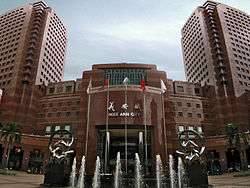
There are various shopping belts in Singapore, Marina Bay, Bugis Street, Chinatown, Geylang Serai, Kampong Gelam & Arab Street, Little India, North Bridge Road, Orchard Road, and The Suburbs.
Singapore seeks to be the business hub of Southeast Asia and has an expansive shopping precinct located in the Orchard Road district. Many multistorey shopping centres are located at Orchard Road; the area also has many hotels, and it's the main tourism centre of Singapore, other than the Downtown Core. The local populace also use Orchard Road for shopping extensively.
Island resorts
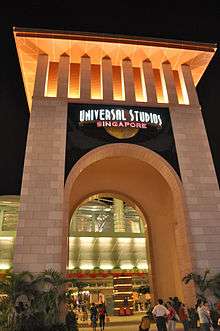
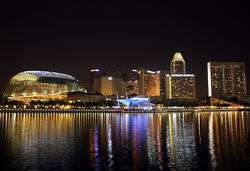
Sentosa is a relatively large island of Singapore located to its south. Along with a beach-front resort, the island's tourist attractions include Fort Siloso, its historical museum, the SEA Aquarium, and Madame Tussauds Singapore. Singapore also features two casinos (integrated resorts), one the Marina Bay Sands and the other, Resorts World Sentosa (home to Universal Studios Singapore and Adventure Cove Waterpark)
Cultural and historical landmarks
A former British colony, Singapore has various historical and cultural landmarks with British and regional influences in its architecture. Such cultural landmarks include the Masjid Sultan, one of Singapore's most important mosques which was completed in 1826, the Thian Hock Keng, one of Singapore's oldest temples, which was completed in 1839 and the Sri Mariamman Temple, which was built in 1827, making it the oldest Hindu temple in Singapore.[12] Other historical monuments include the Kranji War Memorial, Civilian War Memorial, Victoria Theatre and Concert Hall and Istana Kampong Glam.
Singapore has four major museums depicting the art and history of the country and of the region. The Asian Civilisations Museum specialises in the material history of China, Southeast Asia, South Asia and West Asia, from which the diverse ethnic groups of Singapore trace their ancestry, while the Peranakan Museum, the first of its kind in the world, explores Peranakan cultures in Singapore and other former Straits Settlements in Malacca and Penang, and other Peranakan communities in Southeast Asia.[13] Singapore's National Museum of Singapore is the oldest museum in the country, with its history dating back to 1849, mainly showcases collections of nation-building and the history of Singapore from the 14th century in a story-telling approach,[14] while the Singapore Art Museum is a contemporary art museum focusing on art practices in Singapore, Southeast Asia and Asia. Other smaller museums include Changi Museum, which showcases collection of paintings, photographs and personal effects donated by former POWs(Prisoners of War) during the Japanese Occupation of Singapore[15] and the Mint Museum of Toys, which has a collection of 3,000 toys and childhood memorabilia from the mid-19th century to mid-20th Century.
Nature sight-seeing
.jpg)
Singapore has a variety of parks and projects which often feature its natural tropical environment.
Singapore has 3 zoos, namely, the Singapore Zoo, Night Safari and River Safari. The Singapore Zoo displays animals in 'open' naturalistic, spacious, landscaped enclosures separated from the visitors by hidden barriers, moats, and glass, with various shows and events occurring throughout the day to allow visitors to interact with the animals.[16] Night Safari is the world's first nocturnal zoo, set in a humid tropical forest that is only open at night, it is divided into seven geographical zones, which can be explored either on foot via four walking trails, or by tram. River Safari features a tropical rainforest setting[17] and features 10 different ecosystems around the world, with 5000 animals of 300 species. Among the main attractions in the River Safari is a pair of male and female giant pandas – Kai Kai (凯凯) and Jia Jia (嘉嘉)[18] – which are housed in a specially constructed climate-controlled enclosure which change throughout the four seasons emulating their original environment.[19]
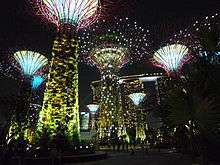
Among the various gardens and parks located in the country, Singapore's Singapore Botanic Gardens, Jurong Bird Park and Gardens by the Bay are most popular amongst tourists. The Singapore Botanical Gardens, a UNESCO World Heritage Site is a 52 hectares tropical garden, among its main attractions includes the National Orchid collection with over 3000 types of orchids growing. Jurong Bird Park, is a bird zoo with extensive specimens of exotic bird life from around the world, including a flock of one thousand flamingos. The bird park is largest in the world in terms of the number of birds. Gardens By The Bay, designed as a series of large tropical leaf-shaped gardens, each with its own specific landscaping design, character and theme. Its main attractions are the two conservatories, the Flower Dome, which replicates a mild, dry climate and features plants found in the Mediterranean and other semi-arid tropical regions, and the Cloud Forest, which replicates the cool moist conditions found in tropical mountain regions between 1,000 metres (3,300 ft) and 3,000 metres (9,800 ft) above sea level, found in South-East Asia, Middle- and South America. Other main attractions include the Supertree Grove, which features tree-like structures, known as Supertrees that dominate the Gardens' landscape. They are vertical gardens that perform a multitude of functions, which include planting, shading and working as environmental engines for the gardens.
Singapore also has two ASEAN Heritage Parks, which are the Bukit Timah Nature Reserve, an extensive nature reserve which covers much of the Bukit Timah Hill, and is the only remaining place where primary rainforest still exists on the island, and the Sungei Buloh Wetland Reserve, which is known for its high variety of bird species, crabs, mudskippers and flora and fauna.
Pulau Ubin, is an offshore island where the last of undeveloped kampongs (villages) and wooden jetties, relaxed inhabitants, rich and preserved wildlife, abandoned quarries and plantations, and untouched nature still exists. One of the more popular spots on the island is, Chek Jawa, a previous coral reef 5000 years ago, where several ecosystems can be observed in one area.
Dining
The cuisine of Singapore is often viewed by its population as a prime example of the ethnic diversity of the culture of Singapore. In Singapore's hawker centres – a technical misnomer, to be precise – for example, traditionally Malay hawker stalls selling halal food may serve halal versions of traditionally Tamil or Chinese food. Chinese stalls may introduce Malay or Indian ingredients, cooking techniques or entire dishes into their range of catering. Some dishes introduce elements from all three cultures, while others incorporate influences from the rest of Asia and the West.
This phenomenon makes the cuisine of Singapore significantly rich and a cultural attraction. Much prepared food is available in the hawker centres or food courts (e.g. Lau Pa Sat, Newton Food Centre) rather than actual restaurants. These centres are relatively abundant which often leads to low prices, and encourages a large consumer base.
Food in itself has been heavily promoted as an attraction for tourists, and is usually promoted by various initiatives undertaken by the Singapore Tourism Board or the associations it deals with as one of Singapore's best attractions alongside shopping. The government organises the Singapore Food Festival in July annually to celebrate Singapore's cuisine. The multiculturalism of local food, the ready availability of international cuisine, and their wide range in prices to fit all budgets at all times of the day and year helps create a "food paradise" to rival other contenders claiming the same moniker. The availability of variety of food is often aided by the fact Singapore's port lies along strategic routes. Catherine Ling of CNN listed Fish soup bee hoon, Bak kut teh, Chilli crab, Nasi Padang, Hainanese chicken rice, and Kaya toast as some of the "40 Singapore foods we can't live without".[20]
There is also a proliferation of fast-food chains, such as McDonald's, Pizza Hut, KFC, Burger King, Subway, Long John Silver's, and Mos Burger.
Halal and vegetarian food are also easily available.
Tourist events
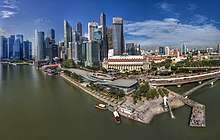
Singapore Tourism Board promotes a variety of events all year round for tourists. Some of the anchor events are the Chingay Parade, Singapore Arts Festival and Singapore Garden Festival. The Singapore Food Festival is held every July to celebrate Singapore's cuisine. Other annual events include the Singapore Sun Festival, the Christmas Light Up, and the Singapore Jewel Festival.[21] Singapore hosted a round of the 2008 FIA Formula One World Championship (Singapore Grand Prix).[22] The race, held on a new street circuit at Marina Bay, was the first night-time event in Formula One history. The event was considered an overall success due to the sheer amount of organisation, planning and hard work put into the event.[23] Also in 2010, Singapore hosted the inaugural Youth Olympic Games, where the Singapore Tourism Board (STB), which say the Games is expected to generate a minimum of 180,000 visitor nights for Singapore.[24]
Challenges to the tourism industry
Health issues
The outbreak of COVID-19 in the city has affected the numbers of foreign visitors. In February 2020, Indonesia raised its travel alert for Singapore to level yellow, urging Indonesian citizens to take extra precautions when they visit the city-state.[25] Indonesia is among the top source of foreign visitors to Singapore. It is predicted that the number of visitors could fall between 25 and 30 percent from the 2019 figure.[6]
See also
- Visa policy of Singapore
- Communications in Singapore
- Culture of Singapore
- History of Singapore
- History of the Republic of Singapore
- Landmark sites in Singapore
- Media of Singapore
- Singapore Tourism Board
- Transport in Singapore
References
- "Singapore tourism sector performance breaks record for the second year running in 2017". Singapore Tourism Board. 12 February 2018. Archived from the original on 16 February 2018. Retrieved 16 February 2018.
- "Singapore is 2nd most visited city in Asia-Pacific, 5th in the world: Mastercard". The Straits Times. 26 September 2018. Archived from the original on 1 October 2018. Retrieved 1 October 2018.
- "Travel and Tourism Competitiveness Report 2015 – Singapore". weforum.org. Archived from the original on 27 September 2016. Retrieved 25 September 2016.
- "The Travel & Tourism Competitiveness Report 2017". World Economic Forum. Archived from the original on 25 October 2017. Retrieved 25 October 2017.
- Wildlife Reserves Singapore Club (20 March 2013). "About River Safari" (PDF). Wildlife Reserves Singapore Club. Archived (PDF) from the original on 2 December 2013. Retrieved 27 November 2013.
- Tay, Tiffany Fumiko (11 February 2020). "Singapore's visitor arrivals down by about 20,000 a day amid coronavirus outbreak". The Straits Times. Retrieved 11 February 2020.
- "Singapore Annual Tourism Statistics Report for 2014" (PDF). Singapore Tourism Board. Retrieved 4 September 2016.
- Jalelah Abu Bakr (21 January 2017). "China overtakes Indonesia as Singapore's top market for tourists". Archived from the original on 23 January 2017. Retrieved 23 January 2017.
- "International Visitor Arrivals (2005–2018)". Singapore Tourism Board. Archived from the original on 22 January 2017. Retrieved 24 February 2019.
- "Tourism Statistics Publications" (PDF). Singapore Tourism Board. Archived from the original (PDF) on 27 December 2013. Retrieved 23 June 2014.
- Excludes Malaysian citizens arriving by land.
- "The Top 10 Singapore Landmarks". Trip Adviser. Archived from the original on 24 July 2015. Retrieved 7 December 2016.
- "Singapore's Newest Museum Opens: showcasing the finest and most comprehensive Peranakan collection in the world" (Press release). Asian Civilizations Museum. 17 April 2008.
- Clara Chow, "National Museum opens after $132m makeover", The Straits Times, 8 December 2006
- Nick Meo (23 August 2006). "Singapore war internee's art on show". BBC. Archived from the original on 5 March 2016. Retrieved 7 January 2016.
- Catharine E. Bell (January 2001). Encyclopedia of the World's Zoos. Taylor & Francis. p. 1155. ISBN 978-1-57958-174-9.
- Mustafa Shafawi, Hetty Musfira (21 May 2010). "Attractions of Asia's first river-themed park River Safari unveiled". Channel NewsAsia. Archived from the original on 24 May 2010. Retrieved 20 October 2010.
- "Relax – S'pore's giant pandas named Kai Kai and Jia Jia". Archived from the original on 31 August 2011. Retrieved 4 January 2016.
- Wildlife Reserves Singapore Staff. "River Safari – Official Page". Wildlife Reserves Singapore. Archived from the original on 10 September 2010. Retrieved 8 October 2010.
- Ling, Catherine (14 April 2010). "40 Singapore foods we can't live without". CNN. Archived from the original on 4 August 2014. Retrieved 10 August 2014.
- What's Happening in Singapore Archived 19 February 2018 at the Wayback Machine, VisitSingapore.com.
- "Singapore confirms 2008 night race". Archived from the original on 13 June 2007. Retrieved 11 May 2007.
- "Archived copy". Archived from the original on 26 February 2012. Retrieved 28 March 2009.CS1 maint: archived copy as title (link)
- "Inaugural Youth Olympic Games will boost Singapore's tourism industry". Channel NewsAsia. 23 February 2008. Archived from the original on 25 February 2008. Retrieved 24 February 2008.
- Nathalia, Telly (10 February 2020). "Indonesia Raises Travel Alert for Singapore After City-State Declares Orange Alert for Coronavirus Outbreak". Jakarta Globe. Retrieved 11 February 2020.
External links
| Wikivoyage has a travel guide for Singapore. |
- Library resources in your library and in other libraries about Tourism in Singapore
- Singapore Tourism Board
- VisitSingapore.com – The official destination website of Singapore
